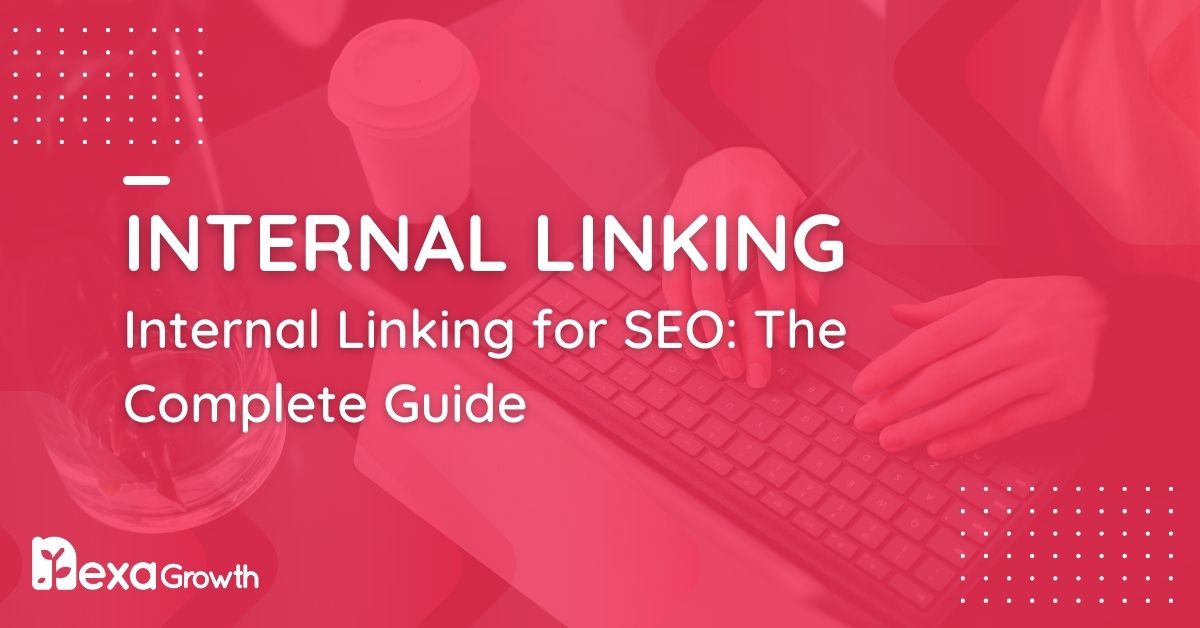- Internal linking involves using hyperlinks to connect pages within the same website.
- Internal links are crucial for helping search engines navigate a website and understand its content structure.
- A good internal linking strategy leads to faster indexing of new pages and helps distribute “link equity.”
- Best practices include creating a logical, pyramid-like site structure and using contextual links within content.
- Internal links also improve user experience by helping with content discovery and reducing bounce rates.
Imagine walking into a library where books are scattered randomly on the floor—no sections, no catalog, just a mess. Finding relevant information would be a nightmare, right?
Now, think of a well-organized library, where books are grouped by category, each with a table of contents and index pages that guide you to the right sections.
This is precisely what internal linking does for your website—it helps both users and search engines navigate efficiently, improving your site’s discoverability and SEO performance.
Internal links are the connective tissue of your website. They help search engines understand your content structure, distribute link equity (ranking power), and improve user engagement.
In this comprehensive guide, we’ll break down everything you need to know about internal linking for SEO, including:
- The best SEO practices to structure your site for maximum impact.
- Advanced strategies like topic clusters, hierarchical linking, and AI-powered automation.
- How to audit and optimize your internal linking for better rankings.
- The most common mistakes to avoid when linking internally.
By the end of this guide, you’ll have a clear internal linking strategy that improves your search rankings, enhances user engagement, and boosts your website’s overall performance.
Rise to the Top—Let’s Optimize!
Your website deserves the spotlight. Our expert SEO strategies put you ahead of the competition. Let’s grow your rankings today!
Contact UsWhat Are Internal Links?
Internal links are hyperlinks that connect one page of a website to another page within the same domain.
Unlike external links, which direct users to a different website, internal links help establish a structured navigation system within your site.
They guide users through related content, improving engagement and SEO.
Internal Links vs. External Links
Understanding the difference between internal and external links is crucial for an effective linking strategy:
- Internal Links: These connect pages within the same website, helping distribute authority and improve site navigation. Example: A blog post linking to a related service page.
- External Links: These direct users from your website to another site. Example: Linking to a study from an authoritative source.
Both types of links are important for SEO, but internal links give you greater control over how search engines and users navigate your site.
Types of Internal Links
Internal links serve different functions depending on their placement and purpose. The main types include:
- Navigational Links: Found in site menus, footers, and sidebars, these help users move between key sections of your website.

An Example of Navigational Links - Contextual Links: Embedded within content, these direct users to related articles, service pages, or resources.
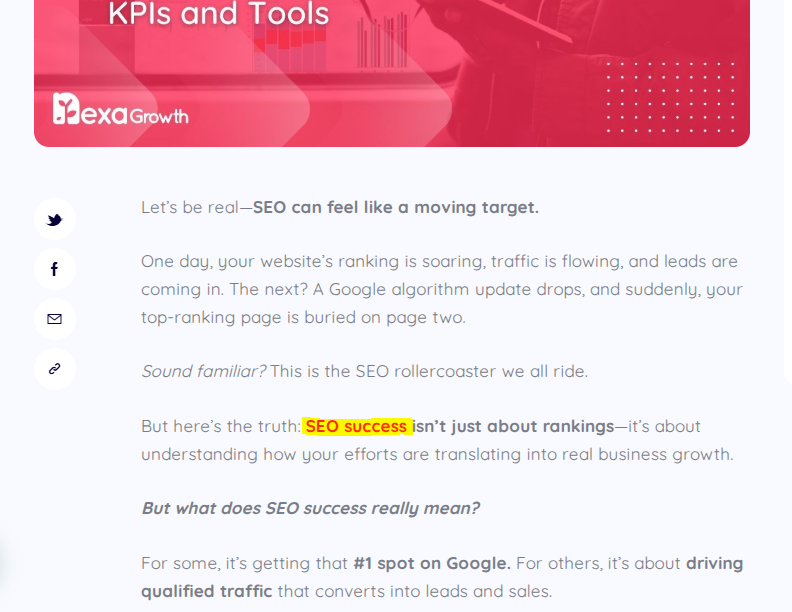
An Example of Contextual Links - Breadcrumb Links: Displayed at the top of a page, these show users their path within the site hierarchy (e.g., Home > Blog > SEO Strategies).
- Taxonomy Links: Found in category and tag pages, helping organize content based on topics.
- Call-to-Action (CTA) Links: Direct users toward conversions, such as booking a consultation or subscribing to a newsletter.
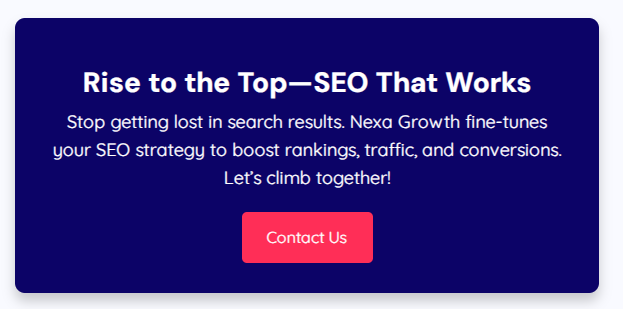
An Example of Call-to-Action Links
Each type plays a role in improving both user experience and search engine understanding of your content structure.
Key Stats That Prove the Power of Internal Linking
- Internal links can boost organic traffic by up to 40% when optimized properly.
- A case study by Ahrefs found that 66.5% of pages have no internal links pointing to them, making them “orphaned” and nearly invisible to search engines.
- 93% of top-ranking pages have strong internal linking structures.
How Internal Linking Impacts SEO and UX
- Boosts Page Authority: Internal links pass link equity from high-authority pages to weaker ones, improving their rankings.
- Helps Google Discover and Index Pages Faster: Googlebot relies on internal links to find and index new pages more efficiently.
- Improves User Experience (UX): A well-linked site keeps visitors engaged longer by guiding them to relevant content, reducing bounce rates.
- Enhances Topic Relevance and Context: Internal linking helps Google understand the relationship between pages, strengthening your site’s topical authority.
Featured Article: The Role of SEO in Digital Marketing: Why It’s Essential for Success
Why Internal Links Matter for SEO
Internal linking is one of the most powerful yet often overlooked SEO strategies.
It helps search engines understand your website structure and improve user engagement, distribute ranking power, and enhance the discoverability of your content.
How Google Understands Internal Links
Google’s algorithm relies heavily on internal links to crawl and index pages.
When Googlebot visits a webpage, it follows internal links to discover new content, determining how pages relate to each other.
According to Google’s Search Central documentation:
“The number of internal links pointing to a page is a signal to search engines about the relative importance of that page.”
This means that pages with more internal links from authoritative sources on your site are likely to be considered more important and rank higher.
The Impact of Internal Links on Crawling and Indexing
- Faster Indexing: Googlebot uses internal links to find new pages. If a page isn’t linked internally, search engines may struggle to discover it.
- Content Relationship Mapping: Internal linking helps Google understand topic relevance and the relationship between different pages.
- Avoiding Orphaned Pages: Pages without any internal links can be deemed virtually invisible to search engines.
How Internal Links Distribute Link Equity (PageRank)
PageRank, a fundamental concept in SEO, refers to the authority a webpage holds. Internal links distribute this authority across your site, strengthening the ranking potential of linked pages.
How Link Equity Works
- Pages with high authority (e.g., homepage, well-linked blog posts) pass ranking power to other pages they link to.
- Internal linking helps spread authority evenly across important pages, ensuring none are left isolated.
- The proper distribution of link equity prevents content decay, ensuring evergreen pages maintain their rankings.
For example, if your homepage has a high PageRank, linking strategically to service pages and blog posts ensures they benefit from that authority, improving their chances of ranking.
Internal Linking and User Experience (UX)
Internal linking isn’t just for search engines—it significantly impacts how users interact with your site.
- Enhances Content Discovery: Visitors can easily navigate to related topics, keeping them engaged.
- Reduces Bounce Rate: Well-placed internal links encourage users to explore more pages rather than leaving immediately.
- Increases Time on Site: By guiding users through a structured content journey, internal links improve dwell time, a potential ranking factor.
- Encourages Conversions: Linking strategically to product pages, case studies, or CTAs can direct users toward business goals.
Featured Article: SEO vs. SEM: What’s the Difference & Which One Is Right for You?
Internal Linking for SEO: Best Practices
A well-structured internal linking strategy is essential for both SEO and user experience.
When done correctly, it helps search engines understand your site structure, ensures important pages receive proper link equity, and keeps users engaged by guiding them through relevant content.
Below are the best practices for an effective internal linking strategy.
-
Establish an SEO-Friendly Site Structure
Your website should follow a logical hierarchy to make it easy for both users and search engines to navigate. The ideal structure resembles a pyramid:
- Homepage (at the top)
- Main Category Pages (pillar pages or core service pages)
- Subcategory Pages (specific topics, service breakdowns, or product pages)
- Individual Blog Posts or Landing Pages
- Subcategory Pages (specific topics, service breakdowns, or product pages)
- Main Category Pages (pillar pages or core service pages)
A flat site architecture (where every page is only a few clicks away from the homepage) makes it easier for Google to crawl all pages efficiently.
- Homepage (at the top)
-
Determine Your Most Important Pages (Cornerstone Content)
Cornerstone content refers to the most valuable, authoritative pages on your website. These pages should be internally linked frequently to establish their importance.
To determine cornerstone content:
- Identify high-value pages such as service pages, product pages, or in-depth blog posts.
- Link to these pages from multiple related pages within your site.
- Ensure they provide comprehensive and evergreen information.
By strategically interlinking cornerstone content, you help search engines and users recognize them as key resources.
-
Use Contextual Links to Strengthen Topic Relevance
Contextual linking is one of the most effective internal linking techniques. By naturally embedding links within relevant content, you:
- Improve topic authority by connecting related content.
- Help search engines understand content relationships.
- Increase time on site by encouraging users to explore more pages.
Example of Contextual Linking
Instead of writing:
“Learn more about site structure here.”Use:
“A well-optimized site structure ensures better crawlability and indexing by search engines.” -
Optimize Anchor Text for Internal Links
The anchor text (the clickable text in a hyperlink) plays a crucial role in SEO. Search engines use it to understand what the linked page is about.
Best Practices for Anchor Text
- Use descriptive, keyword-rich text rather than generic phrases like “click here” or “read more.”
- Keep it natural and relevant to the linked page’s content.
- Avoid over-optimizing with exact-match keywords, as Google may flag it as manipulative.
Example:
✅ “Learn how to create an SEO-friendly internal linking structure for better rankings.”
❌ “Click here to learn more.” -
Link Hierarchical Pages for Better Navigation
Hierarchical linking involves connecting parent, child, and sibling pages to establish a clear content structure.
- Parent Pages: Broad topics (e.g., “SEO Strategies”).
- Child Pages: More specific subtopics (e.g., “Internal Linking for SEO”).
- Sibling Pages: Related pages at the same level (e.g., “On-Page SEO Techniques”).
By linking these pages together, you create strong topic clusters, improving topical relevance and boosting rankings.
-
Use Breadcrumb Navigation to Improve UX and SEO
Breadcrumbs provide a clear path for users to navigate your site and help Google understand the page hierarchy.
For example:
Home > SEO Guides > Internal Linking for SEO
Benefits of breadcrumbs:
- Improve crawlability and site navigation.
- Reduce bounce rates by helping users explore related content.
- Increase the chances of appearing in search results, as Google often displays breadcrumbs in SERPs.
-
Add Internal Links to Related Posts and Navigational Sections
To keep users engaged, include links to related content within blog posts and articles.
- “Related Posts” Section: Display articles relevant to the current topic at the end of a blog post.
- Sidebar Links: Feature high-performing or popular articles in the sidebar.
- In-Content CTA Links: Guide users to conversion pages (e.g., service pages, lead forms).
-
Utilize Taxonomies (Categories and Tags) for Strategic Linking
Taxonomy-based internal linking groups content under categories and tags, making it easier to find related content.
- Categories should be broad topics (e.g., “SEO,” “PPC,” “Content Marketing”).
- Tags should be more specific subtopics (e.g., “Internal Links,” “Backlinks,” “Keyword Research”).
By interlinking category and tag pages, you reinforce topic authority and improve crawl efficiency.
-
Link to Recent and Popular Posts to Drive Traffic
New content often struggles to rank immediately. By linking from high-traffic older posts, you:
- Pass link authority to new pages.
- Increase the chances of faster indexing.
- Drive consistent traffic to important content.
Similarly, linking to popular posts from your homepage or sidebar ensures that users discover your best-performing content.
-
Avoid Common Internal Linking Mistakes
To maintain a strong internal linking strategy, avoid these pitfalls:
- Too Many Internal Links Per Page: Overloading a page with links dilutes link value and confuses users.
- Broken or Redirected Links: Regularly audit links to fix any errors.
- Orphaned Pages: Ensure every page has at least one internal link pointing to it.
- Unnatural Anchor Text: Avoid stuffing keywords unnaturally in internal links.
- Deeply Buried Pages: Ensure important pages are no more than three clicks away from the homepage.
Advanced Internal Linking Strategies
Once you’ve implemented the fundamental best practices, you can take your internal linking strategy further with advanced techniques.
These strategies will help you build topical authority, improve ranking distribution, and ensure your internal links are working efficiently.
-
Implement Topic Clusters for Stronger SEO
Search engines favor well-structured content that demonstrates expertise on a topic.
Topic clusters group related content under a pillar page, making it easier for search engines to understand topic relevance.
How Topic Clusters Work
- Pillar Page: A comprehensive, high-authority page covering a broad topic (e.g., “Internal Linking for SEO”).
- Cluster Pages: More detailed pages addressing subtopics (e.g., “How Anchor Text Affects Internal Linking” or “How Internal Linking Boosts Page Authority”).
- Internal Links: Cluster pages link back to the pillar page and to each other, reinforcing topic relevance.
Benefits of Topic Clusters
- It helps Google recognize topical authority and improves rankings.
- Ensures all related content is easily discoverable through internal links.
- Creates a seamless user experience, guiding visitors through related topics.
-
Optimize Internal Linking for Faster Indexing and Higher Rankings
Google prioritizes pages that are well-connected within a website. To ensure your new content ranks quickly:
- Link from High-Authority Pages: New pages gain traction faster when linked from pages with strong backlink profiles.
- Ensure New Pages Are No More Than Three Clicks from the Homepage: Deeply buried pages are harder for search engines to find.
- Use HTML Links Instead of JavaScript-Based Links: Google sometimes struggles to crawl JavaScript-generated links.
-
Use Internal Linking to Improve E-Commerce SEO
For e-commerce sites, internal linking plays a crucial role in category and product discoverability.
E-Commerce Internal Linking Best Practices
- Link from Category Pages to Best-Selling Products: Prioritize high-converting products in internal links.
- Use “Related Products” or “Customers Also Bought” Sections: Helps increase session duration and product visibility.
- Optimize Breadcrumb Navigation: This ensures product pages remain connected to higher-level categories.
-
Use No-follow Links Strategically
While internal links should generally be followed to distribute link equity, some cases warrant the use of no-follow attributes.
When to use no-follow on internal links:
- Login and Admin Pages: Prevents search engines from wasting crawl budget.
- Duplicate or Thin Content Pages: Avoids passing link equity to low-value pages.
- Certain Affiliate or Outbound Links: Helps prevent dilution of authority.
Google no longer strictly blocks no-followed links from passing any value, but they should still be used selectively.
-
Audit and Optimize Internal Links for Maximum SEO Impact
Regularly reviewing and improving your internal links ensures your site remains SEO-friendly and well-structured.
How to Audit Internal Links
- Use Google Search Console
- Navigate to “Links” under the Search Console dashboard.
- Identify pages with too few or too many internal links.
- Analyze Internal Links With SEO Tools
- Ahrefs: Provides internal linking reports showing link flow and orphaned pages.
- Screaming Frog: Crawls websites and highlights broken or redirected internal links.
- Semrush: Identifies pages with weak internal link structures.
- Fix Broken and Redirected Internal Links
- Redirect 404 pages to relevant content.
- Replace outdated internal links to ensure content remains fresh.
- Ensure Internal Link Distribution is Balanced
- Pages with zero internal links (orphaned pages) should be linked to relevant articles.
- Avoid concentrating all links on one page while neglecting others.
- Use Google Search Console
-
Automate Internal Linking with AI and SEO Plugins
Manually managing internal links can be time-consuming, especially for larger websites. AI-driven tools and plugins simplify this process.
Best Tools for Internal Linking Automation
- Yoast SEO (Premium):
- Provides internal linking suggestions while writing.
- Identifies orphaned content with no internal links.
- Helps optimize anchor text for better SEO.
- Link Whisper:
- Uses AI to suggest relevant internal links automatically.
- Tracks internal link metrics to ensure a balanced strategy.
- Rank Math:
- Provides link suggestions within WordPress.
- Analyzes internal link strength across different pages.
- Yoast SEO (Premium):
Benefits of Internal Linking Automation
- Saves time by suggesting contextual internal links instantly.
- Reduces the risk of orphaned pages.
- Helps maintain a well-balanced linking structure as your content grows.
By implementing these advanced internal linking techniques, you can improve your website’s search visibility, user experience, and overall SEO performance.
More Clicks, More Conversions, More Growth!
SEO isn’t just about traffic—it’s about results. Get a tailored strategy that drives real business growth with Nexa Growth.
Contact UsInternal Linking Audit and Optimization
A strong internal linking strategy requires ongoing maintenance to ensure all links remain effective and contribute to your SEO success.
Conducting regular audits helps identify broken links, orphaned pages, and areas where link equity isn’t distributed optimally.
-
Conduct an Internal Linking Audit
An internal linking audit ensures:
- Search engines can efficiently crawl and index all pages.
- Important pages receive enough internal link equity to rank well.
- Users can navigate your site easily without encountering broken or unnecessary links.
- You eliminate orphaned pages that lack internal links and get ignored by search engines.
Without regular audits, your internal linking strategy may become inefficient, leading to lost ranking opportunities.
How to Audit Your Internal Links Using SEO Tools
Performing a manual audit for small websites is possible, but for larger sites, SEO tools streamline the process. Here’s how to conduct an audit:
Step 1: Use Google Search Console
- Go to Google Search Console > Links
- Identify pages with too few or no internal links
- Check for pages that receive too many links, which may dilute link equity
Step 2: Use Screaming Frog to Identify Issues
- Run a crawl of your website using Screaming Frog SEO Spider
- Look for:
- Broken internal links (404 errors)
- Redirect chains (multiple redirects slowing down link flow)
- Orphaned pages (pages with no internal links pointing to them)
Step 3: Use Ahrefs or Semrush to Find Link Equity Distribution
- Ahrefs Site Audit can show pages receiving too much or too little link equity
- Semrush Internal Link Report identifies weak internal linking patterns
Step 4: Manually Review Important Pages
- Ensure cornerstone content and high-converting pages are well-linked
- Check that service pages, product pages, and long-form guides have sufficient internal links
-
Fixing Broken and Redirected Internal Links
Here’s how you can fix broken and redirected internal links:
How to Handle Broken Links (404 Errors)
- Use 301 redirects to point broken links to relevant content
- Replace outdated links with updated URLs
- Remove links to deleted pages that no longer serve value
How to Optimize Redirect Chains
- If a link redirects multiple times (301 → 301 → 301), update it to point directly to the final URL
- Avoid unnecessary temporary redirects (302s) unless absolutely needed
-
Optimizing Internal Link Distribution for SEO
Once broken links and redirects are fixed, optimize how internal links distribute authority.
Prioritize Internal Links to High-Value Pages
- Identify priority pages (e.g., pillar content, lead generation pages, key landing pages)
- Add relevant internal links from high-traffic pages to these priority pages
Ensure Even Distribution Across the Site
- Avoid excessive links to one page while leaving others under-linked
- Ensure all pages are accessible within three clicks from the homepage
Use an Internal Linking Spreadsheet
Keeping a record of internal links helps track:
- Which pages link to cornerstone content
- How many links each page has
- What anchor texts are being used
-
Managing Orphaned Pages (Pages With No Internal Links)
Orphaned pages are invisible to search engines because no other pages link to them. To fix:
- Identify orphaned pages using Google Search Console, Screaming Frog, or Ahrefs
- Find relevant content on your site where you can naturally link to these pages
- Update existing pages to include links to orphaned content
-
Using Internal Links to Improve Crawl Budget
Google allocates a crawl budget for every website, meaning it can only crawl a limited number of pages at a time.
To optimize your crawl budget:
- Ensure important pages receive direct internal links from well-crawled pages
- Remove unnecessary links to low-value pages (e.g., outdated posts, tag pages with no unique content)
- Use a site structure where all pages are accessible in three clicks or less
-
Measuring Internal Linking Success
After optimizing your internal links, measure their impact using:
- Google Analytics: Track how internal links affect session duration, page views per session, and bounce rate
- Google Search Console: Monitor changes in organic rankings for pages after improving internal links
- Ahrefs/Semrush Internal Link Reports: See improvements in link flow and rankings over time.
Featured Article: Types of SEO in 2026: On-Page, Off-Page, Technical, Local and More
Internal Linking Automation With AI and Plugins
Manually managing internal links can be time-consuming, especially for large websites with hundreds or thousands of pages.
Automation tools powered by AI and SEO plugins can streamline the process, ensuring optimal link distribution, better crawl efficiency, and enhanced user experience.
Why Automate Internal Linking?
Using automation tools for internal linking offers several benefits:
- Saves Time – Manually inserting internal links across hundreds of pages is inefficient. Automation tools suggest relevant internal links instantly.
- Improves SEO Consistency – Ensures that important pages always receive internal links and that orphaned pages don’t go unnoticed.
- Optimizes Link Distribution – AI-driven tools analyze which pages need more link equity and suggest links accordingly.
- Prevents Human Errors – Eliminates issues like broken links, excessive linking, and poor anchor text usage.
Best AI and SEO Plugins for Internal Linking Automation
Let’s take a look at some of the best AI and SEO plugins for internal linking automation:
-
Yoast SEO (Premium)
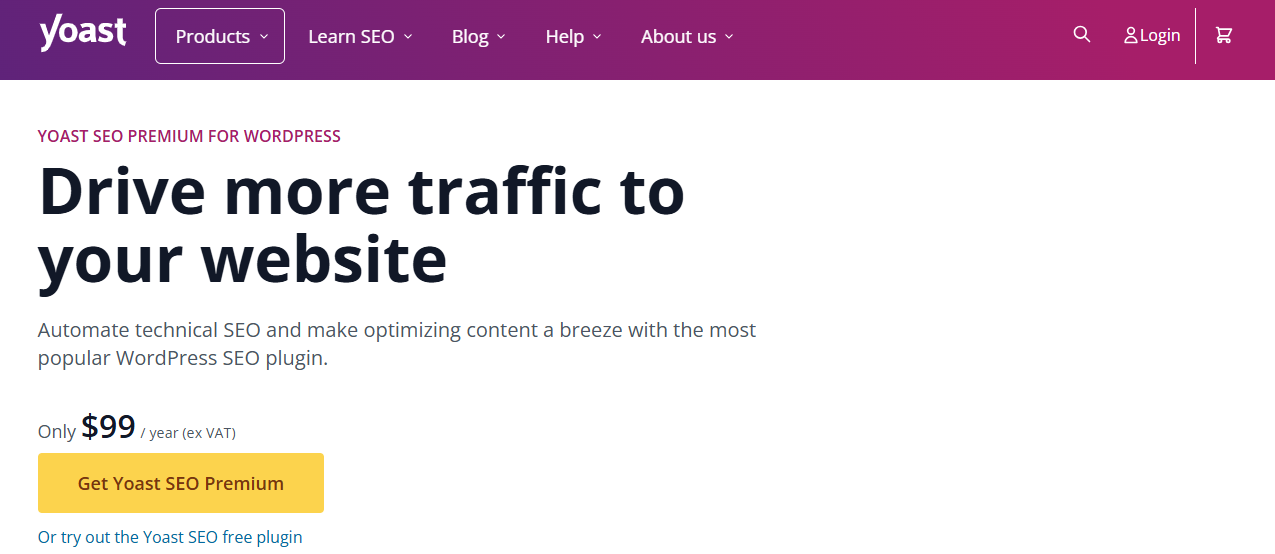
Yoast SEO Plugin Yoast SEO Premium is a widely used WordPress plugin that offers internal linking suggestions while writing content.
Features:- Internal Linking Suggestions – Recommends relevant pages to link to within your content.
- Text Link Counter – Shows how many internal links a page has and how many other pages link to it.
- Orphaned Content Detection – Identifies pages with no internal links, helping you fix overlooked content.
-
Link Whisper
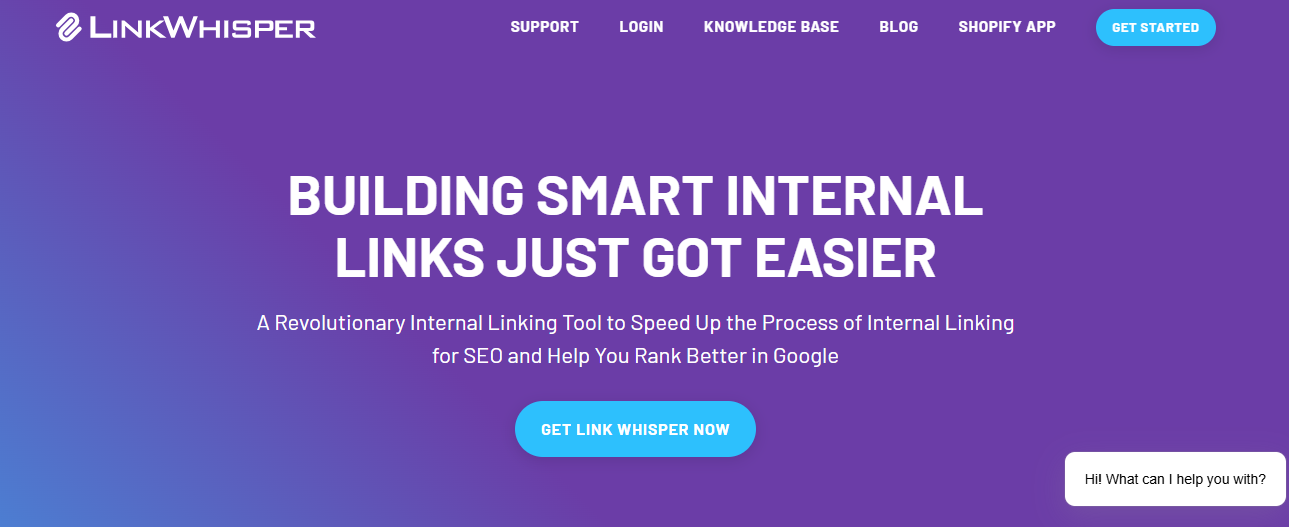
Link Whisper’s Webpage Link Whisper is an AI-powered tool designed to automate and optimize WordPress internal linking.
Features:
- AI-Powered Link Suggestions – While writing or editing content, it suggests relevant internal links.
- Bulk Internal Link Editing – Allows you to add multiple internal links to different posts in one click.
- Orphaned Page Detection – Identifies pages with zero internal links and provides link suggestions.
- Anchor Text Optimization – Helps ensure internal links use SEO-friendly anchor text.
-
Rank Math SEO
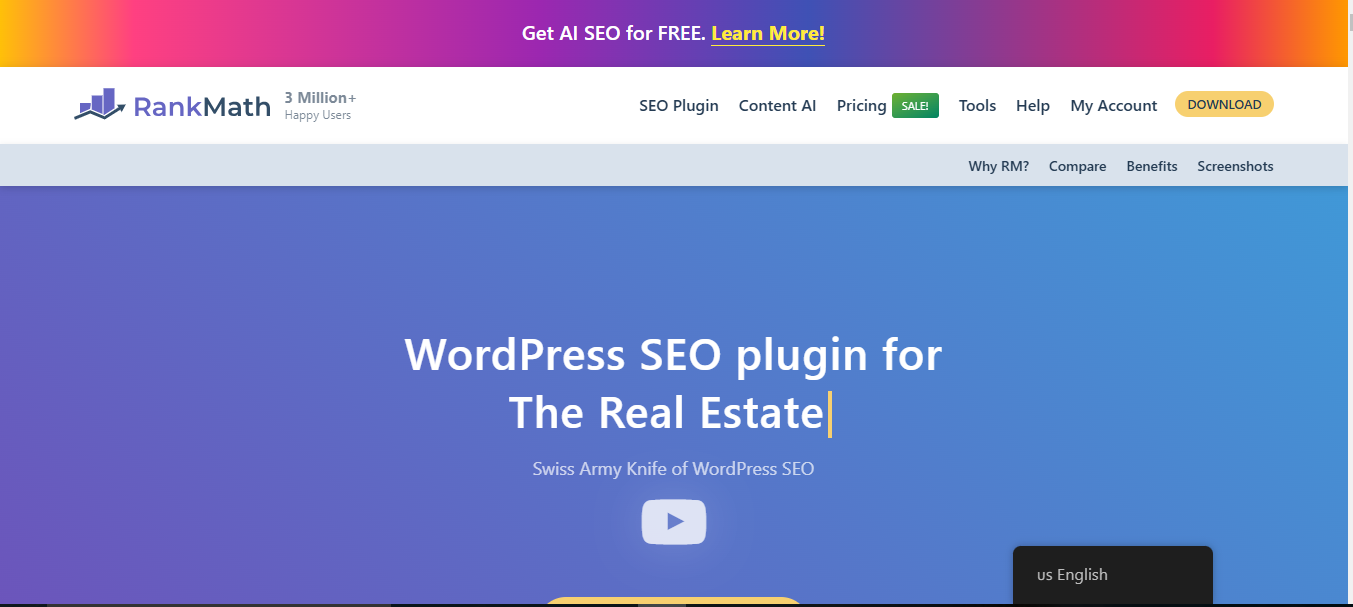
Rank Math SEO’s Webpage Rank Math is another popular WordPress SEO plugin that includes internal linking automation.
Features
- Link Suggestions – Offers real-time internal link recommendations.
- Content AI Integration – Uses AI to optimize links for better SEO.
- Advanced Analytics – Tracks internal linking performance to ensure proper distribution.
-
Ahrefs and Semrush Internal Link Reports
While Ahrefs and Semrush don’t automate link placement, they provide valuable insights to optimize your internal linking strategy.
Features:
- Internal Link Flow Analysis – Helps identify which pages have too few or too many internal links.
- Broken Link Detection – Flags internal links that lead to 404 errors or unnecessary redirects.
- Link Equity Distribution Reports – Ensures that high-authority pages pass link value to weaker pages.
How to Use Automation for Internal Linking
To effectively automate internal linking while maintaining SEO quality:
Step 1: Set Up an Internal Linking Strategy
- Define pillar pages and high-value content that should receive the most links.
- Group related content into topic clusters for better organization.
- Ensure service pages, blog posts, and product pages are well interlinked.
Step 2: Install an Internal Linking Plugin
For WordPress users, installing Yoast SEO Premium, Link Whisper, or Rank Math allows for automatic internal link recommendations.
Step 3: Review AI-Suggested Links
Even with automation, manual review is essential to ensure:
- Links appear naturally within the content.
- Anchor texts are descriptive and varied, not over-optimized.
- Important pages receive the most internal links.
Step 4: Monitor and Adjust Link Distribution
Using Ahrefs, Semrush, or Google Search Console, check:
- Which pages are underlinked and need more internal connections?
- If link equity is evenly distributed across all essential pages.
- If any broken links exist that need fixing.
Step 5: Perform Regular Audits
- Schedule quarterly internal linking audits to optimize underlinked or orphaned pages.
- Remove excessive, low-value links that may dilute link equity.
- Update older content with new internal links to fresh articles.
Avoiding Common Pitfalls in Automated Internal Linking
While automation simplifies internal linking, avoid these mistakes:
- Overusing AI-Suggested Links – Not all suggestions are relevant; always review them before inserting them.
- Forgetting to Link Old Content to New Content – Automation tools primarily work while writing new content, so periodically update old content with new links.
- Ignoring Link Placement – Links should be contextually relevant, not forced into random places.
- Using Excessive Internal Links – Too many internal links on a page can confuse users and dilute SEO value.
Your Growth Starts With Better SEO.
From technical fixes to content optimization, we fine-tune every aspect of your website for maximum visibility. Let’s get started!
Contact UsFinal Thoughts
Internal linking is an ongoing process that requires regular updates and optimization. By applying best practices, using automation tools, and conducting audits, you ensure your website remains well-structured, SEO-friendly, and user-centric.
A strategic internal linking approach will not only boost organic rankings and crawl efficiency but also improve user engagement and conversions—making it a crucial part of your overall SEO strategy.
FAQs
1. How many internal links should I use per page?
- High-value pages receive more internal links to strengthen their authority.
- You don’t overload a page with too many links, as this can dilute link equity.
- Each internal link adds value and context to the user.
For long-form content (2,000+ words), 8–15 internal links are typically effective, depending on the content structure.
2. What is the difference between internal and external links?
- Internal links connect pages within the same website, helping with site navigation and distributing link equity.
- External links point to other websites, providing additional information and improving credibility when linking to authoritative sources.
Both are important for SEO, but internal links give you more control over ranking distribution and user flow.
3. Do internal links help with Google rankings?
- Helping Google discover and index new pages faster.
- Distributing PageRank (link equity) from high-authority pages to lower-ranking pages.
- Improving user engagement by guiding visitors to relevant content, reducing bounce rates.
A well-structured internal linking strategy can significantly improve SEO performance when implemented correctly.
4. How often should I audit my internal links?
- Identify broken or redirected links.
- Fix orphaned pages (pages with no internal links).
- Optimize link distribution to ensure priority pages receive sufficient link equity.
- Update old content with new internal links to keep your site interconnected.
Using tools like Google Search Console, Screaming Frog, Ahrefs, or SEMrush can help automate the auditing process and improve efficiency.

